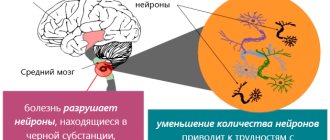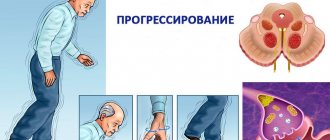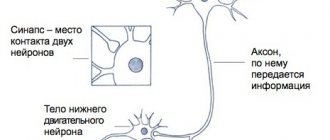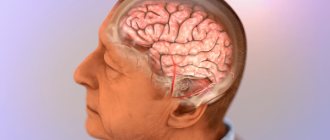Short description
Parkinson's disease (shaking palsy) is an idiopathic slowly progressive degenerative disease of the central nervous system, characterized by slowness of movements, muscle rigidity, tremors at rest and impaired postural reflexes. The disease is based on damage to pigmented dopaminergic neurons of the dense part of the substantia nigra and other dopamine-containing nuclei of the brain stem. The average age of onset of the disease is 57 years. The disease occurs less frequently in smokers, which is associated with the ability of tobacco smoke to inhibit MAO B. 5–24% of patients have a family history. Frequency. 1% of the population over 65 years of age; 0.4% of the population is over 40 years old.
Code according to the international classification of diseases ICD-10:
- G20 Parkinson's disease
Genetic classification
• Parkinson's disease with Lewy bodies (168601, Â) is characterized by early onset (on average at 47 years), rapid progression (death on average at 56 years), and absence of tremor. Pathomorphology: Lewy bodies in the cytoplasm of neurons.
• Juvenile parkinsonism (*600116, PDJ gene, 6q25.2–q27, r) is registered up to 40 years of age. Classic symptoms: bradykinesia, muscle rigidity, tremor. There is no dementia. Pathomorphology: neuronal degeneration and demyelination in the dense part of the substantia nigra and locus coeruleus; Lewy bodies are absent. Most cases have been recorded in people born from consanguineous marriages.
• Familial Parkinson's disease type 1 (#601508, PARK1 gene, 4q21–q23, 163890, Â) occurs due to mutations in the a - synuclein gene (163890, SNCA), encoding a presynaptic protein; characterized by early onset (46±13 years) and high penetrance of the gene.
• Perry's disease (*168605, Â) - parkinsonism with alveolar hypoventilation, depression (antidepressants are ineffective); decrease in taurine content in the blood and cerebrospinal fluid.
• Hunt's juvenile parkinsonism (168100, Â) occurs in children and adolescents; characterized by a slow course, classic symptoms of parkinsonism. Pathomorphology: degeneration and death of cells of the lenticular nucleus.
• Predisposition to developing the disease (eg 2p13 locus).
Manifestations of Parkinson's disease according to ICD-10
In addition to the most striking symptoms - “parkinsonism”, the disease also manifests itself in other neurological problems. Outwardly, they look very specific, so the late stage can be noticed even by an unprofessional eye. The patient shows little facial expression, rarely blinks, and speaks quietly and monotonously. Movements become slow, even inhibited. At first, it becomes difficult for the patient to walk and turn around, then fine motor skills of the hands suffer.
The whole posture of a person becomes more “senile” - the back is hunched, the legs shuffle when walking, and the hands cease to help in maintaining balance. Tremors gradually appear - first in the hands, and then in the head. It disappears only in a situation when a person completely relaxes, which means in a dream. Ultimately, the patient becomes disabled, and in addition to physical defects, mental defects also appear. According to ICD-10, Parkinson’s disease is almost always accompanied by dementia, so leaving a patient in the later stages unattended becomes dangerous.
Stages of Parkinson's disease according to ICD-10
Most doctors use the classification of Margaret Hoehn and Melvin Yahr.
It includes 5 main stages and two intermediate ones. They are presented in the table. Classification of Parkinson's disease
| Stage name | External manifestations |
| First | The first parkinsonisms appear only on one limb, usually on the dominant hand. |
| Stage 1.5 | The problems of one limb are joined by the torso. |
| Second | Parkinsonisms appear on the second side, but the overall stability of the body is preserved. |
| Stage 2.5 | General instability appears, but the patient can still control it. |
| Third | The situation gradually gets worse as instability becomes difficult to control, but in general the person is still able to take care of himself. |
| Fourth | The patient can still walk or stand without the help of others, but to care for himself, support is needed, since the hands gradually become immobilized. |
| Fifth | The patient becomes bedridden. He can only move in a wheelchair with assistance. |
Important: With early detection of the disease and taking prescribed medications, the transition to later stages slows down. The patient can lead a normal life for a long time.
Treatment of Parkinson's disease according to ICD-10
To eliminate the symptoms of the disease, strong medications are required, and they often themselves lead to unwanted severe side effects. The list of essential drugs in ICD-10 includes:
- Azilect – prevents the destruction of dopamine. Used in the first stages of the disease.
- Mendylex is an anticholinergic drug that can somewhat reduce parkinsonism.
- Midantan or PC-merz - increase the release of dopamine.
- Mirapex – stimulates the release of dopamine.
- Nakom or Tremonorm - relieve parkinsonism for a long time, compared to other substances.
- Pantogam or pantocalcim - stimulate mental activity.
- Parkon - stimulates the activity of certain brain structures.
All of these drugs require medical prescription and supervision. They can be dangerous even for a healthy person.
Parkinson's disease is defined in ICD 10 as a severe disorder, and without medical help, degeneration occurs quite quickly, which means a person risks becoming disabled in a matter of months. On the other hand, proper care and timely medical assistance make it possible to live normally for many years, although it will not be possible to completely stop the development of the disease.
Causes
Pathogenesis. Death of dopaminergic neurons in the substantia nigra, locus coeruleus and other dopamine-containing areas of the brain (characteristic clinical symptoms of the disease develop after the degeneration of 80% or more of the neurons in the substantia nigra). Decreased dopamine content in the caudate nucleus and putamen.
Pathomorphology. Macroscopically - loss of pigmentation in the substantia nigra and locus coeruleus. Microscopically - rare pigmented neurons; small extracellular melanin deposits resulting from neuronal death; individual neurons are atrophic and depigmented; Some of the surviving neurons contain spherical eosinophilic cytoplasmic inclusions - Lewy bodies.
general information
This block contains a wide range of disorders of varying severity and clinical manifestations, the development of which is always associated with the use of one or more psychoactive substances, prescribed or not prescribed for medical reasons. The three-digit code identifies the substance used, and the fourth code character defines the clinical characteristics of the condition. This coding is recommended for each specified substance, but it should be noted that not all four-digit codes are applicable for all substances.
Identification of a psychoactive substance should be based on as many sources of information as possible. These include self-reported data, results of blood and other body fluids, characteristic physical and psychological signs, clinical and behavioral symptoms, and other apparent data such as the substance in the patient's possession or information from third parties. Many drug users use more than one type of drug. The main diagnosis should, if possible, be established by the substance (or group of substances) that caused or contributed to the clinical symptoms. Other diagnoses should be coded in cases where another psychoactive substance is taken in an amount that causes poisoning (common fourth character .0), harm to health (common fourth character .1), leads to dependence (common fourth character .2) or other disorders ( common fourth character .3-.9).
Only in cases where drug use is chaotic and mixed, or the contribution of different psychoactive substances to the clinical picture cannot be isolated, should a diagnosis of multiple substance use disorder be made (F19.-).
Excludes: abuse of non-addictive substances (F55)
The following fourth characters are used in categories F10-F19:
.0 Acute intoxication
Excludes: intoxications involving poisoning (T36-T50)
.1 Use with harmful consequences
Use of a psychotropic substance that is harmful to health. The damage may be physical (as in cases of hepatitis from self-administered psychotropic substances) or mental (for example, episodes of depressive disorder due to long-term alcohol use).
Psychotropic substance abuse
.2 Dependency syndrome
A group of behavioral, mnestic and physiological phenomena that develop with repeated use of a substance, which include a strong desire to take the drug, lack of self-control, use despite harmful consequences, higher priority of drug use over other actions and obligations, increased tolerance to substances.
A dependence syndrome may refer to a specific substance (eg, tobacco, alcohol, or diazepam), to a class of substances (eg, opioid drugs), or to a broader range of different psychotropic substances.
- Chronic chronic alcoholism
- Dipsomania
- Addiction
.3 Withdrawal syndrome
A group of symptoms of varying combinations and severity that occur during absolute or relative withdrawal of the use of a psychoactive substance after constant use of this substance. The onset and course of withdrawal are limited in time and are related to the type of psychoactive substance and the dose taken immediately prior to cessation or dose reduction. Withdrawal states may be complicated by seizures.
.4 Withdrawal syndrome with delirium
A condition in which the withdrawal symptoms described above (common fourth character .3) are complicated by delirium, described in F05.-. This condition may also be accompanied by seizures. If an organic factor plays a role in the etiology of the disorder, the condition should be classified under F05.8.
- Delirium tremens (alcoholic)
.5 Psychotic disorder
A complex of psychotic symptoms that occur during or after the use of a psychoactive substance, which, however, cannot be explained solely by acute intoxication and which are not part of the withdrawal state. The disorder is characterized by hallucinations (usually auditory, but often of several types), perceptual disturbances, delusions (often paranoid or persecutory), psychomotor disturbances (excitement or stupor), and abnormal affect, ranging from intense fear to ecstasy. Consciousness is usually clear, but there may be some degree of clouding, but without severe confusion.
Alcoholic:
- hallucinosis
- delirium of jealousy
- paranoia
- psychosis NOS
Excludes: alcohol or other psychoactive substance-induced residual and delayed psychotic disorders (F10-F19 with common fourth character .7)
.6 Amnestic syndrome
A syndrome characterized by severe chronic loss of memory for recent and distant events. Direct recall of events in memory is usually not impaired. Memory for recent events is usually more impaired than for distant ones. Usually there is a clearly expressed violation of the sense of time and sequence of events and there are difficulties in mastering new material. Confabulation is possible, but not required. Other cognitive functions are usually relatively well preserved, and amnestic impairment is disproportionate to the severity of other impairments.
- Amnestic disorder associated with the use of alcohol or other psychoactive substances.
- Korsakoff psychosis or syndrome associated with the use of alcohol or other psychoactive substances, or not otherwise specified.
- With an additional code, (E51.2†, G32.8*), if necessary, when the disorder is associated with Wernicke's disease or syndrome.
Excludes: Organic amnestic syndrome not caused by alcohol or other psychoactive substances (F04)
.7 Residual state and psychotic disorder with delayed onset
A disorder in which disturbances in cognition, emotion, personality, or behavior caused by alcohol or a psychoactive substance may persist beyond the period during which the direct influence of the psychoactive substance is evident. The onset of the disorder must be directly attributable to the use of a psychoactive substance. Cases in which the onset of disorders occurs later than the episode (episodes) of psychoactive substance use can be coded with the above-mentioned fourth character only if the obvious attribution of the disorder to the residual effects of the influence of a psychoactive substance is completely proven.
Residual phenomena can be distinguished from a psychotic state partly by their episodic nature, mostly of short duration, and by their duplication of previous alcohol or drug manifestations.
Alcoholic dementia NOS
Chronic alcoholic cerebral syndrome
Dementia and other mild forms of persistent cognitive impairment
"Flashbacks"
Delayed-onset psychotic disorder due to psychoactive substance use
Impaired perception after using a hallucinogen
Residual:
- emotional [affective] disorder
- personality and behavior disorder
Excluded:
- alcohol or drugs:
- Korsakov's syndrome (F10-F19 with a common fourth sign of .6)
- psychotic state (F10 - F19 with common fourth character .5)
.8 Other mental and behavioral disorders due to substance use
.9 Mental and behavioral disorder due to psychoactive substance use, unspecified
Symptoms (signs)
Clinical picture
• Main symptoms •• Tremor (4–8 Hz) at rest in 50–80% of patients. Tremor in Parkinson's disease is a rhythmic trembling of the second, third and opposite first finger of the hand; in typical cases, it resembles rolling a bread ball with your fingers (similar to “rolling pills”, “counting coins”); at the onset of the disease, one-sided (hemitremor); maximum at rest (static tremor); decreases or disappears with movement; absent during sleep; increases with emotional stress and fatigue; occurs more often on the hands, less often on the legs; trembling of the jaw, tongue, eyelids is also observed •• Progressive slowing of movements (bradykinesia), limitation of the volume and speed of movements (hypokinesia), difficulties in initiating a motor act (akinesia). Movement disorders in Parkinson's disease lead to the appearance of a mask-like face (amimia) with an open mouth, hunched posture (supplicant posture), shuffling mincing gait, lack of cooperative arm movements when walking (acheirokinesis) •• Impaired postural reflexes lead to propulsion (an irresistible acceleration of the patient's movement forward when walking or after a slight push) and retropulsion (involuntary acceleration of backward movement after a push in this direction) •• Muscle rigidity. Muscle tone is changed like a lead pipe; gear phenomenon.
• Associated symptoms •• Speech is slow, inexpressive, unclear, quiet, stuttering (parkinsonian dysarthria). No intonation (monotonous speech) •• Visual disorders: decreased number of blinking movements (von Stellwag symptom), blepharospasm (convulsive blinking or contraction of the orbicularis muscle of the eye and eyelid), gaze spasm (involuntary upward turning of the eyes with prolonged [up to several minutes] holding them in this position); symptom of doll's eyes (Aronovich's symptom) - when the head is tilted forward, the eyeballs move up, when the head is tilted back, the eyeballs move down •• Seborrhea (hypersteatosis, steatosis) - increased function of the sebaceous glands, leading to excessive secretion of sebum (sebaceous face symptom) •• Autonomic disorders: constipation, orthostatic hypotension, urinary and fecal incontinence, sexual dysfunction •• Dementia develops in 50% of patients, more often at the onset of the disease with bilateral damage.
Wolff-Parkinson-White syndrome in children
Congenital pathology in children manifests itself in the first year of life. It has been proven that hereditary predisposition is transmitted in an autosomal recessive manner.
In infants, an attack of paroxysmal tachycardia can be complicated by the development of heart failure and impaired liver function.
It is possible to suspect the presence of pathology at an early age based on the following signs:
- decreased appetite;
- manifestation of shortness of breath;
- low blood pressure;
- presence of pulsation in the chest in the area of the heart;
- low activity.
If a child has a sign of WPW syndrome once recorded on an ECG (even without a clinical picture of the disease), there is a high probability that at an older age he will develop paroxysmal tachycardia. There is a risk of developing life-threatening conditions and sudden death.










